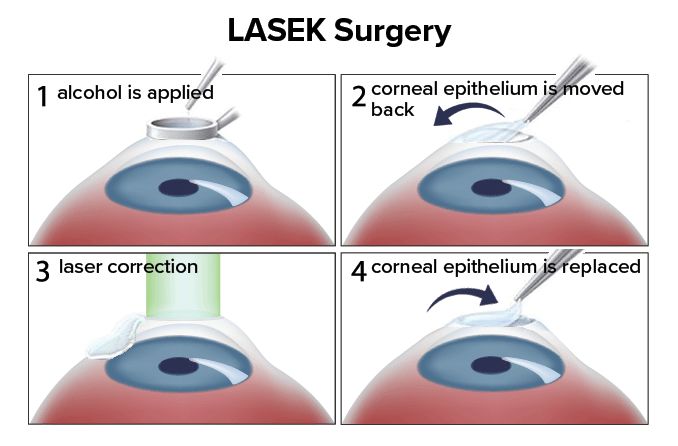2. Extensive Experience: With over ten years of experience, Assoc. Prof. Dr. Kılıç demonstrated her expertise and commitment to improving patients’ lives by performing more than 1,000 Traditional Corneal Ring procedures from 2003 to 2016.
+50.000
Operational Experience
Meet an Advanced Method for Correcting Vision Problems with Laser
Laser PrimeCare
Instant LASEK Experience with Laser PrimeCare

Informative Videos About Laser Eye Treatment






For patients who want to say goodbye to glasses and contact lenses, there are effective treatment options available. Laser surgery is one of the most effective treatments in this regard. It’s worth noting that, with the advancement of technology, laser surgeries have become much more diverse, offering various options. One of the prominent laser treatments in this diversity is LASEK. So, what is LASEK? What advantages does it provide, and how is it applied? Let’s take a closer look.
What is LASEK?
LASEK (Laser-Assisted Sub-Epithelial Keratectomy) is a surface laser treatment that uses an excimer laser to create surface ablations on the cornea without creating a flap.
Unlike common laser treatments like LASIK, no flap is created in this method. Instead, only the laser is used to make the necessary adjustments to the corneal surface, thereby improving the patient’s vision.
This treatment is used to correct common refractive errors such as myopia, astigmatism, and hyperopia.
How is LASEK Surgery Done? How Does the Process Work?
As mentioned, only the laser is used in the procedure, but there is also a setup involved in the surgical process.
Similar to the PRK procedure, in LASEK, the first step is to treat the epithelial tissue on the surface of the eye. A diluted alcohol solution is applied to loosen the tissue. The epithelial layer is then removed.
Afterward, an excimer laser is used to reshape the corneal surface, just as in LASIK. The difference here from PRK is that the epithelial tissue is not discarded but is folded back and repositioned after the laser treatment. This approach helps to speed up the healing process, leading to a quicker recovery for the patient.

Pre-Operative Preparations Are Similar to All Laser Procedures
Like other laser treatments, LASEK has similar pre-operative preparation steps. The process before the surgery can be summarized as follows:
Eye Examination: The patient’s overall eye health is assessed to ensure suitability for the procedure.
Corneal Thickness Measurement: The thickness of the cornea is evaluated to determine if the patient is eligible for LASEK.
Corneal Topography: The surface of the cornea is mapped to ensure proper alignment for the laser treatment.
Check for Other Eye Damage: Any other potential issues with the eye are checked to avoid complications during the procedure.
Once these assessments are complete, if the patient is deemed suitable for LASEK, the laser settings will be customized according to their eye prescription. Overall, the preparation steps for PRK, LASIK, and LASEK are quite similar.
What are the Advantages and Disadvantages of LASEK Treatment?
Advantages
There are some prominent advantages that make LASEK preferable over other laser treatments. We can list them as LASEK advantages.
- It is a laser treatment that can be preferred for patients with thin corneas. Compared to LASIK, it can be applied to thinner corneas because no incision is made.
- The absence of incisions and the lack of flap creation help prevent corneal infections. Potential complications are avoided.
- After the surgery, there is no risk of issues such as flap displacement.
- It is more commonly preferred, especially in patients involved in contact sports, as the risk of eye trauma is lower.
Disadvantages
Just as the treatment has positive aspects, there are also points where it is more disadvantageous compared to other treatments. Let’s list them.
- Pain may last for a few days. A pain-free period does not begin immediately after the surgery.
- You may also experience discomfort for a period of time after the surgery.
- The recovery time may be longer compared to LASIK. Achieving clear vision may take a bit more time.
- Blurry vision may occur for a certain period of time. However, this is considered a temporary condition.
Is there a risk of dry eyes after LASEK?
Since not much intervention is done on the cornea and no flap is created, the risk of dry eyes after LASEK is lower. However, it is important to remember that dry eyes are not solely related to the procedure performed on the cornea.
Preparing the eye surface and tear ducts to optimal levels before the surgery helps minimize the risk of dry eyes. Solutions like Laser PrimeCare can also be used to prepare the eye surface. Similar to other methods, the main goal of Laser PrimeCare is to optimize the eye surface to ensure the best possible preparation. You can get more detailed information right here.
With all this information, we have explained what LASEK is. Remember, when deciding on laser treatment, your doctor’s guidance is crucial. First and foremost, you should have a consultation with an expert doctor to find out which laser treatment will be best for you.
Make an Appointment
Eye Laser Surgery Suitability Test
Why Aylin Kılıç?
Swiss Approach
In Eye Surgery

Aylin Kılıç brings the precision and quality of Swiss innovation together with the warmth and generosity of Turkish hospitality to the world of eye health. Through her innovative approaches, exceptional customer service, and a unique blend of Swiss precision with Turkish hospitality, she continues to improve the lives of individuals around the world.
Who is Assc. Prof. Aylin Kılıç?

Aylin Kılıç is a surgeon who has built an international career in cataract and refractive surgery, as well as keratoconus. Born in 1974, she graduated from Hacettepe University. She gained extensive surgical experience at a young age (with 50,000 surgical procedures by the age of 35), which allowed her to complete her academic career.
Prof. Dr. Aylin Kılıç, who has achieved international success in the fields of cataract, refractive surgery, and keratoconus, is a member of the board of directors of the International Society of Refractive Surgery and has been the Turkey representative of the society since 2008.
Prof. Dr. Aylin Kılıç’s Keranatural Excellence Story – A Journey of Academic Expertise, Innovative Scientific Solutions, and a Unique Experience
1. Legacy of Excellence: Assoc. Prof. Dr. Aylin Kılıç’s journey in KC treatment began in 1997 under the mentorship of Prof. Joseph Colin, who performed the world’s first Corneal Ring procedure for KC. This legacy of excellence formed the foundation of Kılıç’s groundbreaking work in this field.
3. Innovative Techniques: In 2017, Assoc. Prof. Dr. Kılıç introduced the first clinical series of corneal inlays using the Allotex technique, treating 130 cases, including emmetropes and hypermetropes. This innovative approach expanded treatment options for KC patients.
4. International Collaboration: Assoc. Prof. Dr. Kılıç’s collaboration with the U.S. Eye Bank (VisionGift) in 2019 led to the development of the KeraNatural product and the Istanbul nomogram, a pioneering advancement in KC treatment worldwide.
5. Proven Results: From 2019 to 2024, Assoc. Prof. Dr. Kılıç successfully treated over 200 KC cases with Keranatural surgery and provided comprehensive care with 5-year follow-ups. Her work has been recognized with 18 presentations, 3 awards, and 5 scientific academic papers dedicated to Keranatural surgery.
At our clinic, patient care is our top priority, and we strive for excellence in every procedure we perform. If you’re looking for an effective treatment for keratoconus, trust Prof. Dr. Aylin Kılıç and her team to provide you with the highest standard of care using the latest advancements in KC treatment. Contact us today to schedule a consultation and take the first step toward clearer vision and better quality of life with Keranatural surgery.
Achievements
International Awards




















